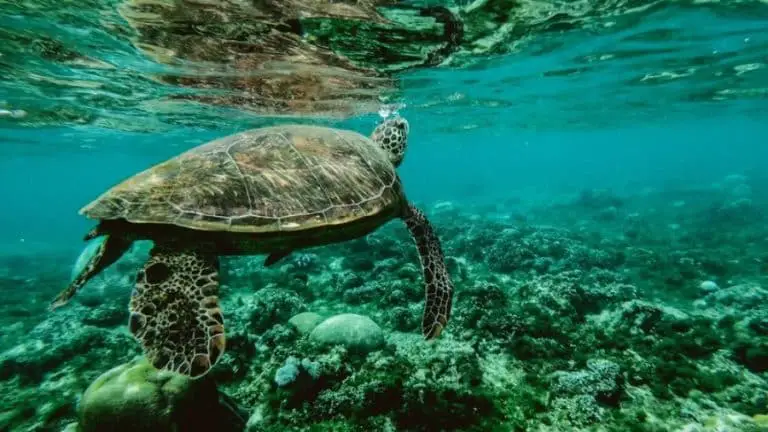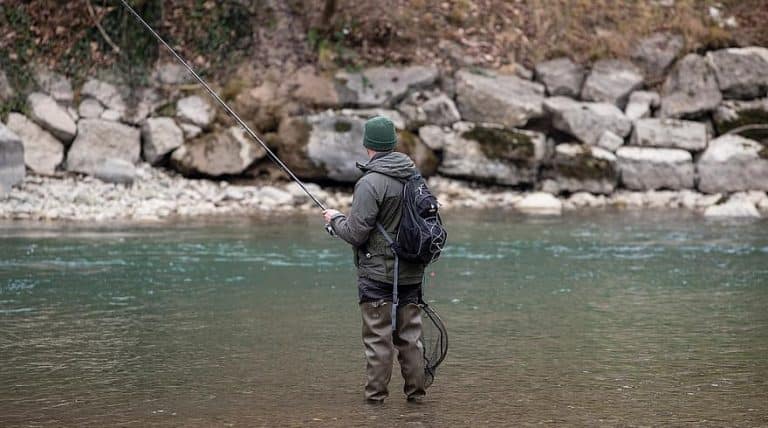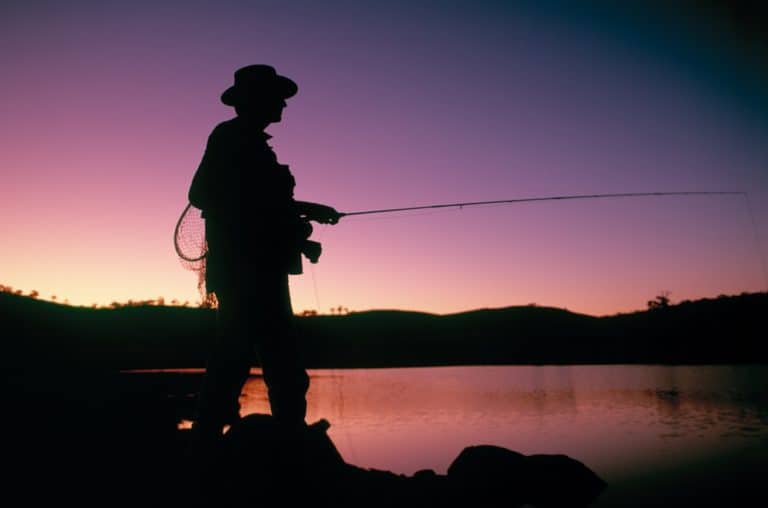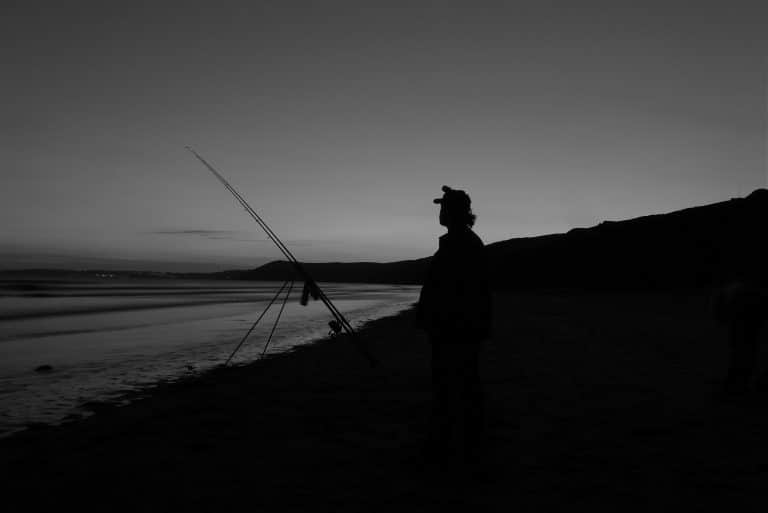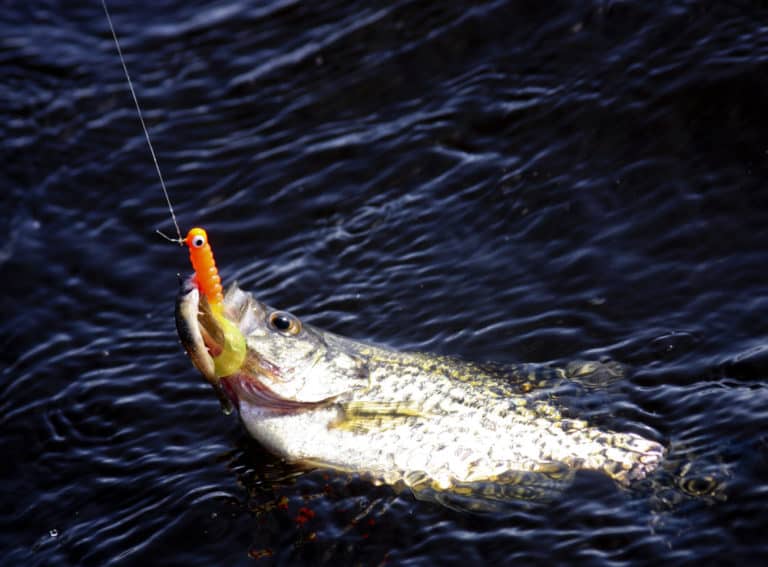Trout Fishing 101: Ultimate Guide To Trout Fishing For Beginners
Trout is one of the most popular fish anglers target in the US and Canada. They are up there in popularity with the likes of Bass, Crappie, and Panfish. Trout fishing does require some knowledge to get started, and as a beginner, nothing seems more daunting than heading out for the first time.
What equipment do you need? Do I need a fly rod, or should I just go spinning? Where do trout live and what rigs can I use to catch them? We have all of this covered. This beginners guide has been written to bring you actionable advice, so you can spend less time behind a screen and hopefully more time outdoors, enjoying the wonderful world of trout fishing.
So let’s begin with some basic questions about where do trout live, and how to find them.
Where do trout live?
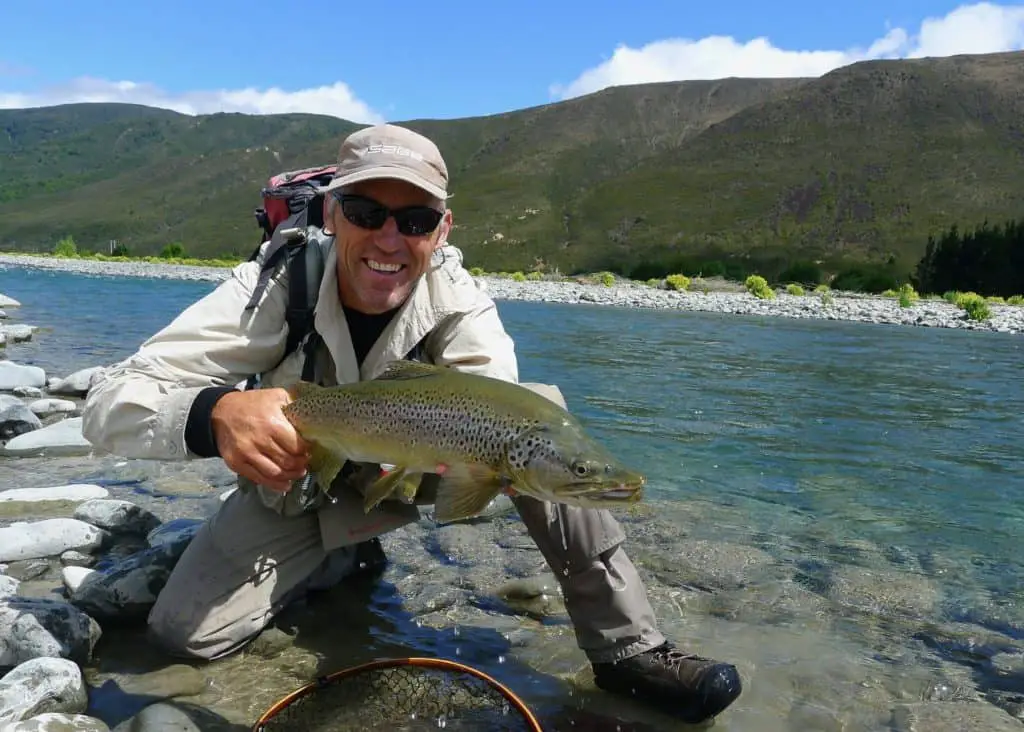
Trout are usually found in cooler waters such as streams, rivers, ponds, and lakes. They are commonly found in Northern America, Northern Asia, and Europe.
As long as the body of water provides the following, you can usually find trout:
- clean & cool water
- rich food source; insects, minnows, and crayfish
- protection from predators; vegetation & cover
Finding Trout in Rivers & Streams:
Rivers and streams are not re-stocked in the same way ponds and lakes are, so if you manage to land a trout here, it’s likely a wild fish. In moving water, trout tend to stay in one position and wait for the current to bring food to them, this is why fly fishing works so well.
There are a few key elements to a river that house trout, as they look for food and protection from predators:
- Slow-moving currents, in and around deeper pools
- Behind structures and rocks (keep an eye out for textured water where water flows over rocks)
- Near banks and steep undercuts (trout will rest here, and wait for food)
Most anglers will go trout fishing in streams and rivers in the spring and fall when the temperature is still fairly low and the water is cool. In the warmer months, look for trout around faster water, and riffles where the water is readily re-oxygenated as it passes over rocks and structures.
Finding Trout in Lakes & Ponds:
Unlike in moving waters, in still water trout will be on the move for food. However, they won’t venture too far away from the protection of their cover. Because of this, there are a few key places you can look for trout in lakes and ponds:
- Vegetation; try landing your bait or lure near, or above the vegetation
- Around cover, structures, logs, and rocks. Usually near river and stream inlets which carry food and cold water into the lake
- In the summer months, trout will retreat to deeper waters where the temperature is lower and there are fewer predators
Most anglers will look for trout around spring and fall in lakes and ponds when the water is cooler and the trout will be more active. If you are fishing a stocked lake, it’s likely it will be re-stocked around this time as well.
Different trout species
Probably, the two most common species of trout are the rainbow and brown trout. Rainbow trout is also commonly referred to as steelhead trout.
Rainbow trout are native to the Pacific Ocean in both Asia and North America. Brown trout are found only in Europe, and are either purely freshwater fish, or anadromous, meaning that they can be found in both salt and freshwater for different stages of their life e.g. spawning.
Trout Fishing Essentials:
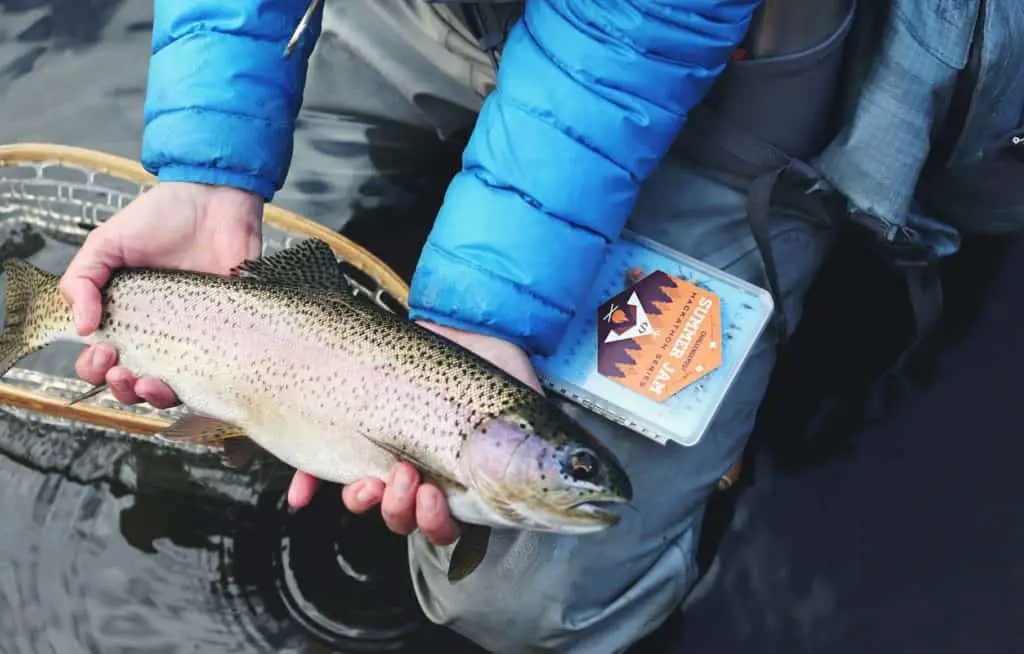
Fishing License & Regulations
One of the most important items that you must take fishing is your fishing license. Without it, you won’t be allowed to fish in a particular region or state. The fees for your license usually get reinvested back into the conservation of the fish, and surrounding areas.
Before you head out somewhere new, always double-check the state-by-state fishing laws and regulations and ensure you abide by them/carry the right license. Some areas will also have daily catch limits and bait restrictions.
Basic Trout Fishing Equipment
Fishing requires some basic pieces of equipment, below we have listed some fishing gear. The essentials are of course your rod, reel, line, and tackle, but there is also some more equipment to consider.
- Fishing Rod; Spinning, Casting or Fly Rod
- Trout Fishing Line
- Fishing Reel; Spinning, Baitcasting or Fly Reel
- Lures, Bait, or Flies
- Fishing Backpack
- Fishing Pliers
Your fishing rod is probably the first piece of equipment you will buy. As a beginner, it is easy to become overwhelmed by the different options, rod action & powers, lengths, and types you can choose from. A rod that is about 6-7ft in length with a medium action is perfect for starting out. It’s a good choice for trout and gives you lots of versatility for going after other fish as well.
Fishing tackle refers to all of your line, lures, hooks, weights, swivels, bait, and more. There are quite literally thousands of different options to choose from here. We would recommend checking out some of the common trout rigs below and making sure that you have the right tackle to build them. You can pick up tackle from your local tackle shop or online.
Your reel choice depends on the type of fishing rod you choose. A fly rod will need a fly fishing reel. Anglers have been weighing up the pros & cons of a spinning rod vs a casting rod for some time. As a beginner, we would recommend going with a spinning rod, as they use spinning reels which are much easier to operate than a baitcasting reel.
Trout Fishing Techniques for Lakes and Ponds
There are many ways to fish for trout, and the more experienced you get as an angler the more styles and rigs you will feel comfortable using. But as a beginner, starting simple is key. Below we will discuss 3 methods you can use to catch trout in lakes and ponds.
- One of the simplest rigs to set up is suspending a hook with bait or a worm underneath a bobber on the surface. You need to attach a small lead weight just above the hook to help the bait sink. Attach the bobber 2-3 feet above the hook, and always use a leader line (usually fluorocarbon line) to prevent the trout from seeing the line. Cast out your rig, and wait for the bobber to jerk and dive. This technique is best used when trout are near the surface, or you want to suspend your bait above a weed bed or structures.
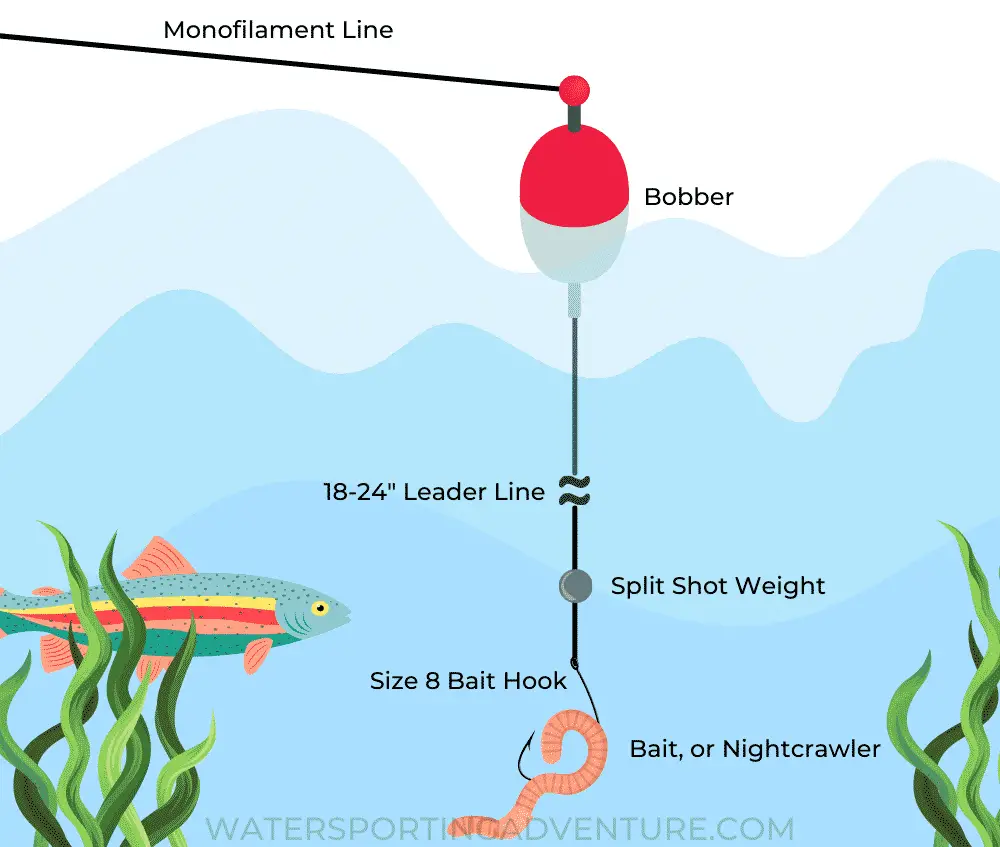
- You can also fish for deeper trout by popping your bait up from the bottom. Using a weight that is attached about 1.5 above the baited hook, you are able to sink your line deep but pop the bait up from the lake bed to hover. This technique is best used with bait that is more buoyant such as power bait.
- You can also use topwater lures and spinners for trout as they mimic baitfish (like minnows) and attract plenty of hungry trout. Similar to how you would fly fishing, you cast your spinner near a trout habitat, let it sink briefly, and start to reel it in (retrieving). You can alter the speed at which you reel in your spinner until you find the right balance. This method is great for covering lots of water quickly.
Trout Fishing Techniques for Rivers and Streams
Trout fishing in rivers and streams uses the waters’ current to create a more life-like bait or lure. Below are some good beginner methods for trout fishing in rivers and streams:
- Similar to how you would in a lake, cast your spinner upstream, but instead of retrieving using your reel, allow the waters’ current to carry the spinner back downstream towards you. Just ensure to use your reel to pick up any slack in the line. The goal here is to get the spinner moving at a similar speed to the water.
- Another good method is to drift a floating bait in the waters’ current. By using the right amount of split shot, you can suspend the weight a few inches above the river bed. You can also add a bobber to help keep track of the drifting bait.
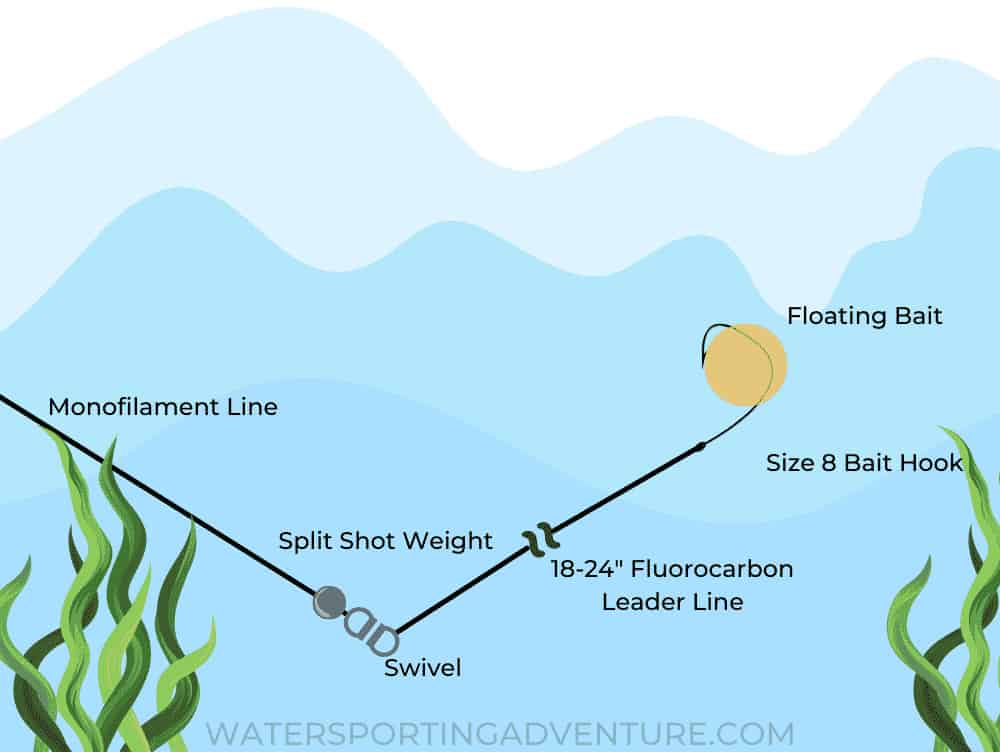
Top Tip: In larger rivers and streams, where the water slows down and forms a large pool. You can use many of the same trout fishing techniques that you would use in small ponds and lakes. E.g. using a bobber and split shot to suspend your bait below the surface of the water.
Fly Fishing For Trout

One of the main differences between using a fly rather than conventional fishing methods such as float fishing or ledgering is that there is no weight in a fly so it cannot be propelled the desired distance during a cast.
Therefore, the angler must use a specially designed rod and reel with a weighted line and a certain casting style, for example, a roll cast, to propel the fly out the required distance needed to reach the feeding fish.
Location
Before selecting a rod, reel and line consideration should be given to where the angler intends to fish and how large the fish are likely to be that the angler may encounter. The size of trout and venues vary greatly, as small wild trout can be caught from tiny streams or hard fighting rainbow trout could potentially be hooked from a large stocked still water.
Fly Fishing Rod Selection
The strength of conventional fishing rods is gauged either in a casting weight or test curve, whereas the strength of fly fishing rods is described with a line weight.
With this in mind, if the angler is to fish in a small stream for small wild trout, then a short rod of 6-7’ with a line weight of 2-3 or 3-4 would be an ideal choice as the fish are small so only a light rod would be needed. A shorter rod is ideal for use in a narrow stream and for casting in between overhanging vegetation which can be encountered when fishing in small streams.
When targeting trout from wide rivers when larger fish will be encountered, then a rod of between 7-9’ with a line weight between 4-5 or 5-6 would be a better choice. Longer rods with lengths of between 9-11’ with a line weight of 6-7 or 7-8 would be a good choice when targeting larger trout, for example stocked rainbows from still waters or reservoirs.
Fly Fishing Reel Selection
Reels are gauged on the same scale as the rods, so it is very straightforward to match a reel to a particular rod, for example, a reel with a 4-5 size will perfectly complement a 4-5 weight rod.
When selecting a reel, the angler should consider the component the reel is manufactured from and whether a reel with a cassette system is needed. Spare spools can be purchased for reels that have a cassette system so the angler can load different lines onto each spool and simply swap spools over if required during the angling trip.
The cheapest type of reel is manufactured from plastic, which will suit anglers that are on a budget or anglers who are new to the sport and do not want to spend too much money straight away. These reels are light but are prone to wearing over time but as they are inexpensive, they are cheap to replace.
If the angler wishes to invest in a better quality reel, then one manufactured from die-cast aluminium should be considered. To be die-cast, molten aluminium is poured into a mould that has been designed by the manufacturer. These reels are more expensive than plastic ones but are more impact resistance and harder wearing so in turn they have a longer life expectancy than a plastic version.
If the angler wishes to purchase a top of the range reel, then one manufactured from machined aluminium would be a good choice. These are constructed from a solid block of aluminium and are machined to tolerances of thousands of an inch. The angler can also opt for reels that have been anodised, meaning that they are suitable to be used in saltwater.
Fly Fishing Line For Trout
Once the angler has purchased a rod and reel, then the next consideration is which type of line to use as an essential part of fly fishing is choosing the correct type of line.
If the angler chooses a floating line, then the whole line will float on the surface which would be ideal when targeting trout in a stream or river. A sinking line would need to be used when fishing on a lake or where there is deep water.
Sinking lines are available at different sink rates. An intermediate line is basically a slow sinking line that gets the fly down slightly deeper and just below the surface. A sinking tip line means that the line floats but the tip sinks so the fly will sink slightly but not to the bottom.
Once the colourful fly line is on the reel, the angler has to then tie on a leader which gives a near invisible connection between the fly line and the fly. Most leaders are tapered, meaning that they have a larger diameter at the end that is tied to the fly line and a smaller diameter at the tip. This means that when the angler casts, it shoots through the air sufficiently enough for the fly to turn over and this in turn helps it to land more softly on the water.
After the leader, the angler can add a tippet, which is a smaller gauge line that is attached to the leader to which the fly is tied on the end. The tippet is generally between 2’ and 4’ long and is very flexible which allows the fly to float or swim naturally depending on the fly pattern used.
Fly Choice
There are many fly fishing flies on the market today, including dry flies, buzzers, nymphs, wet flies and streamers. Some represent small insects for targeting trout and grayling such as a mayfly or a caddis and others are a baitfish profile and are used for such species as
Some essential items that the fly angler will need are a good landing net, un-hooking tools and a spare tippet and leader.
Also of benefit to the angler would be the best fly fishing waders, weighing scales, and a purpose-designed fly fishing life vest.
Final Words
Trout fishing is a great way to get outdoors, and enjoy the thrill of catching a fish that is difficult to find, and puts up a good fight – it makes the catch all the more rewarding.
As a beginner, fishing can seem difficult to grasp, there are so many different types of reels, rods, tackle, rigs, and various hook sizes you need to understand – let alone how to actually find and land a fish!
But, the answers are often simple. And if you want to catch trout, then you have everything you need in this guide. If you have never been fly fishing, then we would recommend sticking with a 6-7ft spinning rod, with a light line and tackle set-up. Using some of the rigs mentioned above for lakes, or rivers.
Finally, best of luck. No matter what trout species you are targeting, or where you are fishing, you are sure to have lots of fun and test your abilities as an angler whilst hunting down trout.


